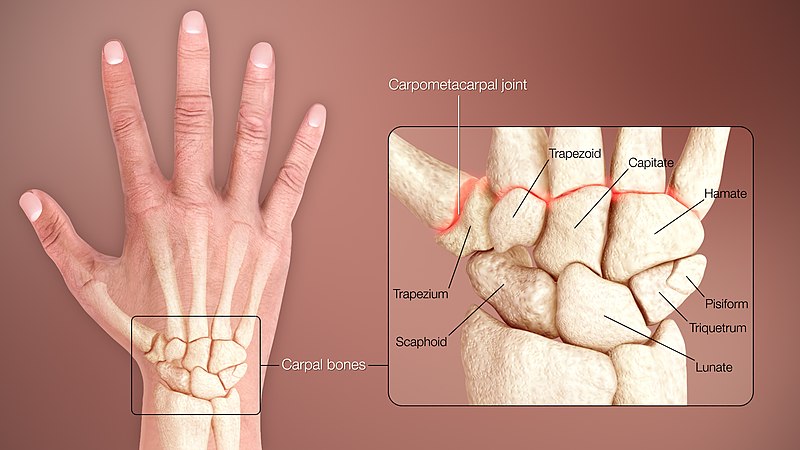Osteoarthritis is a condition where the tissues in our joints start to break down over time. In the UK, over 10 million people are affected by osteoarthritis, with the most commonly affected joints being the knee and hip, due to their high weight-bearing capabilities. The wrist, however, also has a high prevalence in the general population.
Due to the nature of osteoarthritis being a degenerative condition, symptoms can significantly impact day-to-day activities, reducing the movements available at the wrist, and reducing your quality of life.
This blog will discuss in further detail what wrist osteoarthritis is, its causes, symptoms, and available treatment methods.
Wrist anatomy
Firstly, we will look at the anatomy of the wrist, to understand how osteoarthritis affects it.
The wrist is a complex joint, connecting the hand to the forearm. The hand is formed from 14 phalanges (referring to the digits of each finger), connected to 5 metacarpal bones, which then connect to the 8 carpal bones of the wrist. The 8 carpal bones are:
- Scaphoid
- Lunate
- Triquetrum
- Pisiform
- Trapezium
- Trapezoid
- Capitate
- Hamate
The carpal bones are grouped, forming the carpal tunnel, and connect the forearm bones, the radius and the ulna, to the wrist.
The wrist isn’t just made up of bones, however, but also ligaments, tendons, muscles and nerves, such as the radial, median and ulnar nerve. For a more detailed look at wrist anatomy, read The Wrist Joint.
What is wrist osteoarthritis?
Wrist osteoarthritis is a condition in which the wrist joints begin to break down through wear and tear and degeneration. Osteoarthritis affects the articular cartilage in your joints (cartilage where two bones meet), causing it to become rough, as opposed to its usual smooth surface. As the cartilage begins to wear down, the joint struggles to move as easily and freely as it did before, which leads to an onset of symptoms. Due to the cartilage having a very limited blood supply, if any, the process of healing or regeneration is unable to happen, making osteoarthritis a chronic condition that unfortunately usually only gets worse.
Causes of wrist osteoarthritis
As osteoarthritis is a degenerative condition, one of the main causes is wear and tear. Over time and as we age, the natural process of wear and tear in our body begins to take effect. Using our wrists every day for various movements, our bodies naturally begin to wear down, and as we age, we struggle to repair ourselves as quickly to compensate for this.
There are some other risk factors associated with osteoarthritis, however, including our gender, age and genes. Of the 10 million people in the UK affected by osteoarthritis, 60% are female and 40% male. Osteoarthritis is also common in the older population, but more common in women over the age of 50. The development of osteoarthritis has also been shown to run in families, although the identification of a particular gene responsible has not been discovered.
Symptoms of wrist osteoarthritis
The most common symptoms of wrist osteoarthritis are pain, swelling and stiffness. As osteoarthritis begins to develop in the joints, the rough cartilage on the bones sliding against each other causes friction and irritation of the joint. Movements such as flexion and extension of the wrist become more difficult due to the pain and stiffness. The wrist may also swell through inflammation, further limiting the movement of the wrist.
Other possible symptoms include tenderness in the affected area, particularly after flare-ups or increased activity. Some people may even experience a grating sensation due to the rough surface of the cartilage inside the joint.
Diagnosing wrist osteoarthritis
Wrist osteoarthritis can often be easily diagnosed simply through the presentation of symptoms. A clinician may be able to diagnose osteoarthritis if you are experiencing pain, swelling and stiffness at your wrist joint, however, an X-ray may also be helpful to show exactly where the degenerative joint is and its progression. In more complex cases, magnetic resonance imaging (MRI) may be used to show a more detailed picture of the joint, including the cartilage and soft tissue.
Blood tests may also be used, not to necessarily diagnose osteoarthritis, but to rule out other conditions, such as rheumatoid arthritis.
Treatment methods for wrist osteoarthritis
Unfortunately, osteoarthritis is a condition that can’t be undone. Once the joint has begun to wear down, our bodies cannot heal, nor can medication reverse the degeneration. There are still treatment methods, however, that can help relieve the symptoms of osteoarthritis instead.
Medications
Due to osteoarthritis causing swelling and tenderness at the joint, nonsteroidal anti-inflammatory drugs (NSAIDs) are often prescribed to relieve symptoms. The most common NSAID is ibuprofen, an over-the-counter medication, however, stronger NSAIDs may be recommended by a healthcare professional on prescription.
Analgesic medications can also be taken to treat the pain associated with osteoarthritis, such as paracetamol, or prescription opioids containing hydrocodone or oxycodone.
Corticosteroids, or steroids, can help reduce swelling, either via a pill or injection into the site of your osteoarthritis. This medication offers pain relief for up to 2 months, however, it is not a permanent solution as it is recommended you shouldn’t receive more than 4 steroid injections a year.
Therapy
Various forms of therapy can be utilised to treat wrist osteoarthritis such as physical therapy, occupational therapy and transcutaneous electrical nerve stimulation (TENS).
Physical therapy is used to strengthen the surrounding muscles and soft tissue of the affected joint, aiming to reduce pain and increase flexibility. Your healthcare professional or physical therapist can show you exercises, or suggest gentle exercises such as swimming or walking.
Occupational therapy focuses on discovering new ways to complete everyday tasks that may now have become more difficult. This type of therapy finds new ways to brush your teeth or comb your hair, for instance, without putting excess stress on your affected joint.
Finally, TENS therapy uses low-voltage electrical currents that provide short-term relief of painful symptoms. Read more about Electrical Nerve Stimulation for Arthritis Pain.
Surgery
If the above treatments don’t provide relief, surgical options may be discussed with your healthcare professional. A procedure in which the nerves in your wrist are removed (denervation) may help with the pain of osteoarthritis, however, this solution is not often a permanent fix. Another type of surgery involves the fusion of your carpal bones to make one large bone, preventing the friction caused by bones sliding against one another. Finally, total wrist replacement surgeries may be suggested, similar to a total knee or hip replacement surgery.
Each surgery option should be determined by the level and severity of your osteoarthritis, with age and activity level also taken into consideration.
To conclude, wrist osteoarthritis can be a debilitating condition, impacting everyday life and activity levels. As there is no cure, treatment to prevent further degeneration should be started as soon as signs and symptoms occur.
If you are experiencing any of the mentioned symptoms, Ladan Hajipour is an experienced clinician in diagnosing and treating wrist osteoarthritis. Book your appointment today for professional help and advice.





